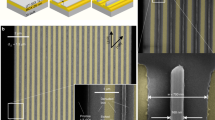Abstract
Substantial effort has been placed on developing semiconducting carbon nanotubes1,2,3 and nanowires4 as building blocks for electronic devices—such as field-effect transistors—that could replace conventional silicon transistors in hybrid electronics or lead to stand-alone nanosystems4,5. Attaching electric contacts to individual devices is a first step towards integration, and this step has been addressed using lithographically defined metal electrodes1,2,3,4,6,7,8. Yet, these metal contacts define a size scale that is much larger than the nanometre-scale building blocks, thus limiting many potential advantages. Here we report an integrated contact and interconnection solution that overcomes this size constraint through selective transformation of silicon nanowires into metallic nickel silicide (NiSi) nanowires. Electrical measurements show that the single crystal nickel silicide nanowires have ideal resistivities of about 10 µΩ cm and remarkably high failure-current densities, >108 A cm-2. In addition, we demonstrate the fabrication of nickel silicide/silicon (NiSi/Si) nanowire heterostructures with atomically sharp metal–semiconductor interfaces. We produce field-effect transistors based on those heterostructures in which the source–drain contacts are defined by the metallic NiSi nanowire regions. Our approach is fully compatible with conventional planar silicon electronics and extendable to the 10-nm scale using a crossed-nanowire architecture.





Similar content being viewed by others
References
Yao, Z., Dekker, C. & Avouris, Ph. Electrical transport through single-wall carbon nanotubes. Top. Appl. Phys. 80, 147–171 (2001)
McEuen, P. L., Fuhrer, M. S. & Park, H. Single-walled carbon nanotube electronics. IEEE Trans. Nanotechnol. 1, 78–85 (2002)
Dai, H. Carbon nanotubes: synthesis, integration, and properties. Acc. Chem. Res. 35, 1035–1044 (2002)
Lieber, C. M. Nanoscale science and technology: Building a big future from small things. MRS Bull. 28, 486–491 (2003)
Lieber, C. M. The incredible shrinking circuit. Sci. Am. 285, 58–64 (2001)
Cui, Y., Zhong, Z., Wang, D., Wang, W. U. & Lieber, C. M. High performance silicon nanowire field effect transistors. Nano Lett. 3, 149–152 (2003)
Javey, A., Guo, J., Wang, Q., Lundstrom, M. & Dai, H. Ballistic carbon nanotube field-effect transistors. Nature 424, 654–657 (2003)
Heinze, S. et al. Carbon nanotubes as Schottky barrier transistors. Phys. Rev. Lett. 89, 106801 (2002)
Morimoto, T. et al. Self-aligned nickel-mono-silicide technology for high-speed deep submicrometer logic CMOS ULSI. IEEE Trans. Electron Devices 42, 915–922 (1995)
Cui, Y., Lauhon, L. J., Gudiksen, M. S., Wang, J. & Lieber, C. M. Diameter-controlled synthesis of single-crystal silicon nanowires. Appl. Phys. Lett. 78, 2214–2216 (2001)
Wu, Y. et al. Controlled growth and structures of molecular-scale silicon nanowires. Nano Lett. 4, 433–436 (2004)
Toman, K. The structure of NiSi. Acta Crystallogr. 4, 462–464 (1951)
Meyer, B. et al. Intrinsic properties of NiSi. J. Alloys Compounds 262/263, 235–237 (1997)
Pierce, D. G. & Brusius, P. G. Electromigration: a review. Microelectron. Reliab. 37, 1053–1072 (1997)
Yao, Z., Kane, C. L. & Dekker, C. High-field electrical transport in single-wall carbon nanotubes. Phys. Rev. Lett. 84, 2941–2944 (2000)
International Technology Roadmap for Semiconductors 2003 edn 〈http://public.itrs.net/Files/2003ITRS/Interconnect2003.pdf〉 (2003).
Sze, S. M. Physics of Semicondutor Devices 438–445 (John Wiley & Sons, New York, 1981)
Huang, Y., Duan, X., Wei, Q. & Lieber, C. M. Directed assembly of one-dimensional nanostructures into functional networks. Science 291, 630–633 (2001)
Chau, R. et al. Silicon nano-transistors for logic applications. Physica E 19, 1–5 (2003)
Whang, D., Jin, S., Wu, Y. & Lieber, C. M. Large-scale hierarchical organization of nanowire arrays for integrated nanosystems. Nano Lett. 3, 1255–1259 (2003)
Lauhon, L. J., Gudiksen, M. S., Wang, D. & Lieber, C. M. Epitaxial core–shell and core–multishell nanowire heterostructures. Nature 420, 57–61 (2002)
Acknowledgements
We thank M. C. McAlpine, C. J. Barrelet and D. C. Bell for discussions. C.M.L. thanks the Defense Advanced Research Projects Agency and Intel for support of this work.
Author information
Authors and Affiliations
Corresponding author
Ethics declarations
Competing interests
The authors declare that they have no competing financial interests.
Rights and permissions
About this article
Cite this article
Wu, Y., Xiang, J., Yang, C. et al. Single-crystal metallic nanowires and metal/semiconductor nanowire heterostructures. Nature 430, 61–65 (2004). https://doi.org/10.1038/nature02674
Received:
Accepted:
Issue Date:
DOI: https://doi.org/10.1038/nature02674
- Springer Nature Limited
This article is cited by
-
Growth and metal-decorated catalytic applications of silicon nanowires: a review
Bulletin of Materials Science (2023)
-
Design and Development of Graphene FET Biosensor for the Detection of SARS-CoV-2
Silicon (2022)
-
Fabrication and temperature-dependent electrical characterization of a C-shape nanowire patterned by a DNA origami
Scientific Reports (2021)
-
Superior Pseudocapacitive Storage of a Novel Ni3Si2/NiOOH/Graphene Nanostructure for an All-Solid-State Supercapacitor
Nano-Micro Letters (2021)
-
Fabrication of DNA/NiSi NWs and Ag NPs-NiSi NWs-based Schottky diodes for DNA detection with fast response time
Journal of Materials Science: Materials in Electronics (2021)





